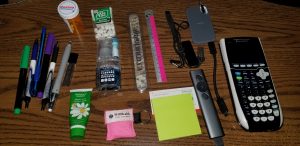My name is Terri-Lynn McLeod. I teach senior high math, science, and a variety of CTS (career and technology) courses at a small junior/senior high school in Wabasca, Alberta, about 350 km north of Edmonton. For this project, I chose the backpack that I take to work at school every day. The picture shows what I found in the one compartment of the bag.

As I emptied the bag, I found things that I use every day and things that I haven’t used in some time, but are there “just in case.” The pens and pencils are still used everyday even though we are progressing towards more digital technologies in our classes. Despite the abundance of technologies available, I still use pens and pencils to record attendance on paper, mark math workbooks, and make notes on planning for my classes. All of the pens and pencils have some text on them somewhere indicating at least the company that produced them. The sticky notes are used in conjunction with the pens to create a type of non-digital text message, possibly to myself, a student, or a colleague. Surprisingly, there was no text on the back of the pad. The highlighters are used less often to identify important information in written documents. I use the calculator on a daily basis as I teach math and physics. The face of the calculator is covered with a variety of text: numbers, symbols, operations, and functions. It does take some special training to be able to decode all of the text on the front of this calculator. For many of the buttons, the text is replicated on the screen. The ruler has mostly numerical text, especially on the front. On the back side, there is a conversion table from inches to millimetres. The flash drives and the portable SSD have very little text on their surfaces, but hold huge quantities of a variety of text in digital form, including books, documents such as tests, and photos. The presentation remote helps me to efficiently share many of the texts on the drives as well as text stored in my Google Drive with students in class.
Some of the more random items in the bag are not directly related to my teaching, but may be helpful during the day: nail file, CPR mask keychain, business card, hand lotion, glasses cleaning kit, mints, and medications. All of them have some sort of text on them, many of the items have text in both English and French and the text is helpful in determining the proper use of the item.
The items in my bag represent a variety of literacies. These literacies include mathematical/numerical literacy, digital literacy, text/reading and writing literacy, technological literacy, media literacy, and health/medical literacy.
Because this is a bag that I take to work and most of the items in the bag are used for my teaching job, the picture painted by the objects in the bag is not particularly private. The one exception is the medication in the bag. It is necessary for my overall well-being but not directly connected to my teaching.
Looking back 20 years, the contents of my bag for work were not so different than they are today. There would have been no presentation remote, or portable SSD. The flash drive would have probably been 128 MB instead of 32GB. There would have been an older model of the calculator with no colour screen or rechargeable battery. I would have had pens and pencils, probably in a greater variety of colours. Many of the other random items would have been there as well, as some things don’t change over the years. Looking forward, an archaeologist would look at my bag and see a time of transition. Look at a pencil beside a 1TB portable drive in the same bag.